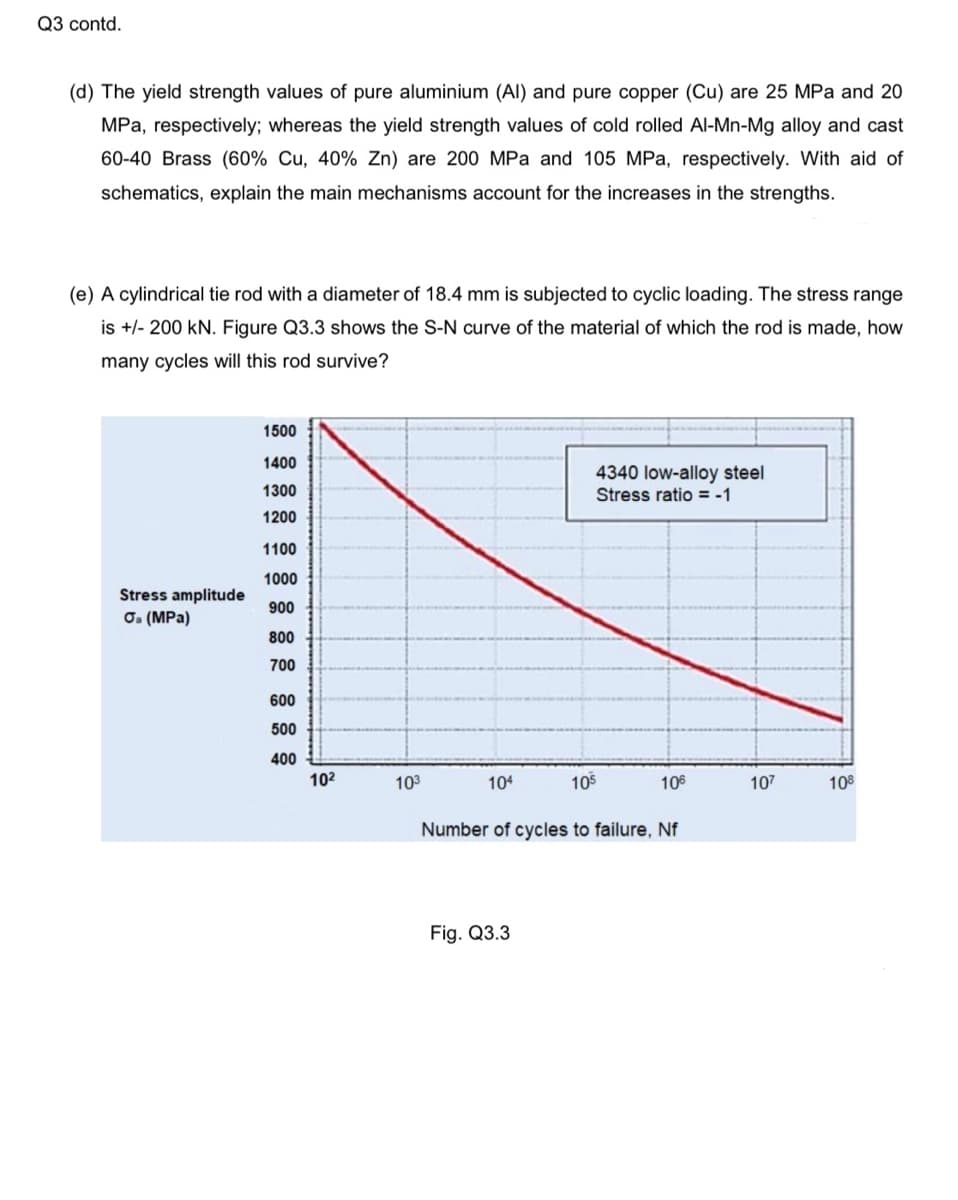(d) The yield strength values of pure aluminium (Al) and pure copper (Cu) are 25 MPa and 20 MPa, respectively; whereas the yield strength values of cold rolled Al-Mn-Mg alloy and cast 60-40 Brass (60% Cu, 40% Zn) are 200 MPa and 105 MPa, respectively. With aid of schematics, explain the main mechanisms account for the increases in the strengths. (e) A cylindrical tie rod with a diameter of 18.4 mm is subjected to cyclic loading. The stress range is +/- 200 kN. Figure Q3.3 shows the S-N curve of the material of which the rod is made, how many cycles will this rod survive? Stress amplitude J. (MPa) 1500 1400 1300 1200 1100 1000 900 800 700 600 500 400 10² 103 104 4340 low-alloy steel Stress ratio= -1 105 106 Number of cycles to failure, Nf 107 108
(d) The yield strength values of pure aluminium (Al) and pure copper (Cu) are 25 MPa and 20 MPa, respectively; whereas the yield strength values of cold rolled Al-Mn-Mg alloy and cast 60-40 Brass (60% Cu, 40% Zn) are 200 MPa and 105 MPa, respectively. With aid of schematics, explain the main mechanisms account for the increases in the strengths. (e) A cylindrical tie rod with a diameter of 18.4 mm is subjected to cyclic loading. The stress range is +/- 200 kN. Figure Q3.3 shows the S-N curve of the material of which the rod is made, how many cycles will this rod survive? Stress amplitude J. (MPa) 1500 1400 1300 1200 1100 1000 900 800 700 600 500 400 10² 103 104 4340 low-alloy steel Stress ratio= -1 105 106 Number of cycles to failure, Nf 107 108
Elements Of Electromagnetics
7th Edition
ISBN:9780190698614
Author:Sadiku, Matthew N. O.
Publisher:Sadiku, Matthew N. O.
ChapterMA: Math Assessment
Section: Chapter Questions
Problem 1.1MA
Related questions
Question

Transcribed Image Text:Q3 contd.
(d) The yield strength values of pure aluminium (Al) and pure copper (Cu) are 25 MPa and 20
MPa, respectively; whereas the yield strength values of cold rolled Al-Mn-Mg alloy and cast
60-40 Brass (60% Cu, 40% Zn) are 200 MPa and 105 MPa, respectively. With aid of
schematics, explain the main mechanisms account for the increases in the strengths.
(e) A cylindrical tie rod with a diameter of 18.4 mm is subjected to cyclic loading. The stress range
is +/- 200 kN. Figure Q3.3 shows the S-N curve of the material of which the rod is made, how
many cycles will this rod survive?
Stress amplitude
O₂ (MPa)
1500
1400
1300
1200
1100
1000
900
800
700
600
500
400
10²
10³
104
4340 low-alloy steel
Stress ratio = -1
Fig. Q3.3
105
106
Number of cycles to failure, Nf
107
108
Expert Solution
This question has been solved!
Explore an expertly crafted, step-by-step solution for a thorough understanding of key concepts.
Step by step
Solved in 3 steps

Knowledge Booster
Learn more about
Need a deep-dive on the concept behind this application? Look no further. Learn more about this topic, mechanical-engineering and related others by exploring similar questions and additional content below.Recommended textbooks for you

Elements Of Electromagnetics
Mechanical Engineering
ISBN:
9780190698614
Author:
Sadiku, Matthew N. O.
Publisher:
Oxford University Press

Mechanics of Materials (10th Edition)
Mechanical Engineering
ISBN:
9780134319650
Author:
Russell C. Hibbeler
Publisher:
PEARSON

Thermodynamics: An Engineering Approach
Mechanical Engineering
ISBN:
9781259822674
Author:
Yunus A. Cengel Dr., Michael A. Boles
Publisher:
McGraw-Hill Education

Elements Of Electromagnetics
Mechanical Engineering
ISBN:
9780190698614
Author:
Sadiku, Matthew N. O.
Publisher:
Oxford University Press

Mechanics of Materials (10th Edition)
Mechanical Engineering
ISBN:
9780134319650
Author:
Russell C. Hibbeler
Publisher:
PEARSON

Thermodynamics: An Engineering Approach
Mechanical Engineering
ISBN:
9781259822674
Author:
Yunus A. Cengel Dr., Michael A. Boles
Publisher:
McGraw-Hill Education

Control Systems Engineering
Mechanical Engineering
ISBN:
9781118170519
Author:
Norman S. Nise
Publisher:
WILEY

Mechanics of Materials (MindTap Course List)
Mechanical Engineering
ISBN:
9781337093347
Author:
Barry J. Goodno, James M. Gere
Publisher:
Cengage Learning

Engineering Mechanics: Statics
Mechanical Engineering
ISBN:
9781118807330
Author:
James L. Meriam, L. G. Kraige, J. N. Bolton
Publisher:
WILEY